26.06.2023
It’s the little known Aussie location that has played a role in one of the biggest moments in world history. Now it has a new challenge.
A little known ex-Aussie NASA base has been earmarked to play a pivotal role in the next space mission led by the United States.
Along with the Parkes Observatory in New South Wales, the Carnarvon Tracking Station, 900km north of Perth, was vital to the success of the historic Apollo 11 moon landing mission.
But while the former starred in an iconic Australian movie and became a household name, the latter got all but forgotten, despite being the largest NASA base outside the United States at the time.

Parkes Observatory in New South Wales became famous due to an Australian movie, while Carnarvon Tracking Station in Western Australia, despite being the largest NASA base outside the US, was largely forgotten. Picture: Stewart Allen
Founder of the Carnarvon Space and Technology Museum Phil Youd has revealed to news.com.au that the site is set to receive a minimum of $10 million for a new 29.6-metre dish by Canadian space company ThothX, which aims to secure a 20-year renewable lease to operate and maintain the facility.
Mr Youd, who now doubles as a director at ThothX, also revealed that the dish’s potential new job won’t be trivial, with the company working on significant US contracts.
“There are thousands of these things (satellites) sitting up there now … they’re getting a contract with the Americans about tracking China because China has been putting all these satellites up there right alongside American ones,” he revealed.
“The theory is if there’s going to be another world war, it’ll start up there because that’s all communications.”
Mr Youd founded the museum to educate locals and tourists on the station’s history, and said he couldn’t sit back and watch the tracking station fade into oblivion – nor could he let Parkes bask in all the glory.
“[Parkes is] famous because of the movie, but there’s not a lot of truth in there. The people who worked at the Carnarvon station often scoff at that movie,” he chuckled.
Apollo 11 astronaut Buzz Aldrin even visited the museum in 2012, and his handprints and signature remain on display.
Carnarvon’s role in the moon landing
Established in 1963 by NASA, this remote outpost played a vital role in both the Gemini and Apollo programs, cementing its place in space exploration history.
The Carnarvon Tracking Station was purpose-built for NASA’s Gemini program, a crucial stepping stone in America’s quest to put a man on the moon.
The site boasted an array of cutting-edge facilities, including the FPQ-6 precision tracking radar, the Spacecraft Tracking and Data Acquisition Network (STADAN), scientific satellite tracking facility, a planet Jupiter monitoring system, and the Solar Particle Alert Network (SPAN) facility. Together, these facilities made the Carnarvon Tracking Station the largest outpost in the NASA network located outside of the US mainland.
As the Gemini program reached its conclusion, the Carnarvon Tracking Station seamlessly transitioned into supporting the momentous Project Apollo missions.
Its strategic geographic location proved indispensable in relaying critical commands to the Apollo spacecraft during the trans-lunar injection phase.
Moreover, the station served as the primary communication link during the spacecraft’s tense re-entry phase into Earth’s atmosphere in the final hours of each mission.
Recognising the significance of the Carnarvon Tracking Station, NASA took further steps to enhance its capabilities.
In 1966, the agency funded the establishment of the OTC Satellite Earth Station Carnarvon, situated nearby, to bolster vital communications between the tracking station and the Houston Control Centre.
This development solidified Carnarvon’s status as a hub of interplanetary communication, enabling seamless data transfer between Earth and astronauts venturing into the unknown depths of space.
Following the triumph of the Apollo program, the Carnarvon Tracking Station lent its support to the Skylab project, NASA’s first space station. However, after the conclusion of Skylab, routine operations at the station came to an end.
The facility’s last mission was the trans-solar insertion of Helios-A, a bittersweet farewell that marked the closing chapter of an extraordinary era.
On April 18, 1975, the gates were shut, yet the legacy of the Carnarvon Tracking Station did not fade away entirely.
Radio Australia, seeking a new home after its Darwin installation was ravaged by Cyclone Tracy in December 1974, repurposed the main building for its operations until 1996.
While the Carnarvon Tracking Station itself may have ceased its operations, the adjacent Overseas Telecommunications Commission (OTC) Satellite Earth Station dish carried on its legacy of scientific research.
This location now serves as a node for the Birmingham Solar Oscillations Network, conducting solar scientific research that builds upon the pioneering work carried out at the Carnarvon Tracking Station.
The site also facilitated the first live television footage to and from Australia. In fact, Carnarvon was the first place in Australia the world ever saw live on TV.
“A lot of people don’t even know that Carnarvon was a part of the moon landing,” Youd said.
For Queensland retirees Ross Hall and his wife Janette, who have stopped to volunteer at the museum while travelling Australia, it represents a formative and nostalgic era for older Australians.
“When I was a boy, 11 years old, this wasn’t history, this was happening, and that’s what made me so interested in space,” he told news.com.au.
“I’m now 65. That’s a long time being a space nerd but heaps of blokes my age are to some extent.
“I’d never heard of Carnarvon just a couple of months ago. Then we come up here, and I just love it. The stories this place tells … I can’t get enough of it.”
His wife Janette also just so happened to be an apprentice at OTC in the 1970s.

Carnarvon Space and Technology Museum volunteer Ross Hall. Picture: Jon Gellweiler/news.com.au
Americans in ‘wild west’ WA
“The Americans put a lot of importance into that site, and the reason for that is because it’s directly opposite from where (Gemini and Apollo missions) took off from in Florida,” Mr Youd explained.
At its peak, over 250 NASA workers temporarily called Carnarvon home during the space race.
By all reports, the relationship between the Carnarvon townsfolk and the American tracking station workers was a good one, though not without its fair share of classic Aussie stitch-ups.
According to Mr Youd, a widely told tale in town is one of an American being promised ‘echidna eggs’ by a local to take home as a souvenir.
Upon the Texan engineer’s departure, one of the locals gave him a matchbox full of cotton and doublegee prickles, convincing him they were the elusive echidna eggs.
“(The Texan) really cracked the sads when he found out that echidna eggs don’t actually exist,” Mr Youd laughed.
“You can imagine coming out here in the early 60s – it was a wild west town of about half the size it is now – compared to what they were used to.”
To the future
ThothX specialises in employing advanced deep space radar technology to track spacecraft in Earth’s geostationary orbit, situated approximately 35,000 kilometres above the planet’s surface and beyond.
Unlike satellites in low Earth orbit, which orbit the planet at a much closer distance and require constant tracking due to their rapid speed, satellites in the geostationary orbit move in sync with the Earth’s rotation.
Caroline Roberts, the CEO of ThothX and its parent company, emphasised the importance of tracking spacecraft and identifying potential threats.
She told ABC in 2022, “Not only are these orbits used by some commercial spacecraft operators for communications, on which we all rely, but these are the orbits that the militaries.”
Given the substantial financial investments associated with spacecraft, Dr Roberts revealed their average cost to be around $1 billion each.
Moreover, there are approximately 2000 satellites in the geostationary orbit, collectively contributing to an estimated value of $2 trillion for this specific orbit.
She said financial significance underscores the need for robust tracking capabilities and preserving spacecraft assets in high-value orbits.
Mr Youd explained how the dish could once again aid the US beyond our atmosphere.
He said it would be used to track satellites as an alternative to optical telescopes and, unlike the optical telescopes, it won’t be affected by wind, rain, cloud or night and day.
Depending on the skills required, he added, Carnarvon locals would be prioritised for the jobs that will come from the refurbishment and operation, with hopes that the dish will become operational by 2024.
Quelle: news.com.au
